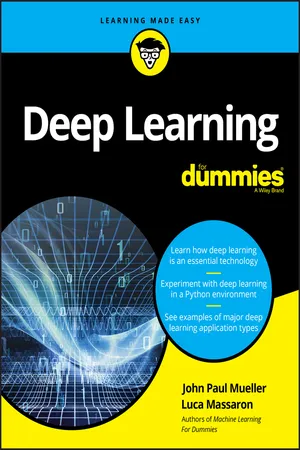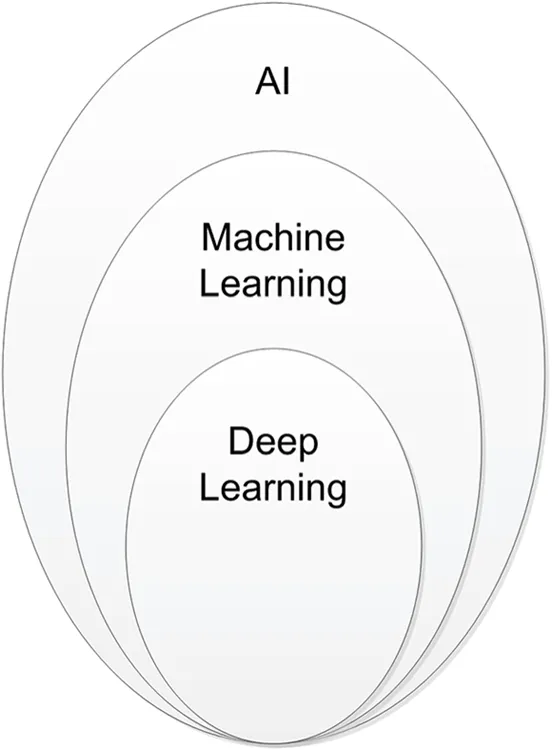
- English
- ePUB (mobile friendly)
- Available on iOS & Android
eBook - ePub
Deep Learning For Dummies
About this book
Take a deep dive into deep learning
Deep learning provides the means for discerning patterns in the data that drive online business and social media outlets. Deep Learning for Dummies gives you the information you need to take the mystery out of the topic—and all of the underlying technologies associated with it.
In no time, you'll make sense of those increasingly confusing algorithms, and find a simple and safe environment to experiment with deep learning. The book develops a sense of precisely what deep learning can do at a high level and then provides examples of the major deep learning application types.
- Includes sample code
- Provides real-world examples within the approachable text
- Offers hands-on activities to make learning easier
- Shows you how to use Deep Learning more effectively with the right tools
This book is perfect for those who want to better understand the basis of the underlying technologies that we use each and every day.
Frequently asked questions
Yes, you can cancel anytime from the Subscription tab in your account settings on the Perlego website. Your subscription will stay active until the end of your current billing period. Learn how to cancel your subscription.
No, books cannot be downloaded as external files, such as PDFs, for use outside of Perlego. However, you can download books within the Perlego app for offline reading on mobile or tablet. Learn more here.
Perlego offers two plans: Essential and Complete
- Essential is ideal for learners and professionals who enjoy exploring a wide range of subjects. Access the Essential Library with 800,000+ trusted titles and best-sellers across business, personal growth, and the humanities. Includes unlimited reading time and Standard Read Aloud voice.
- Complete: Perfect for advanced learners and researchers needing full, unrestricted access. Unlock 1.4M+ books across hundreds of subjects, including academic and specialized titles. The Complete Plan also includes advanced features like Premium Read Aloud and Research Assistant.
We are an online textbook subscription service, where you can get access to an entire online library for less than the price of a single book per month. With over 1 million books across 1000+ topics, we’ve got you covered! Learn more here.
Look out for the read-aloud symbol on your next book to see if you can listen to it. The read-aloud tool reads text aloud for you, highlighting the text as it is being read. You can pause it, speed it up and slow it down. Learn more here.
Yes! You can use the Perlego app on both iOS or Android devices to read anytime, anywhere — even offline. Perfect for commutes or when you’re on the go.
Please note we cannot support devices running on iOS 13 and Android 7 or earlier. Learn more about using the app.
Please note we cannot support devices running on iOS 13 and Android 7 or earlier. Learn more about using the app.
Yes, you can access Deep Learning For Dummies by John Paul Mueller,Luca Massaron in PDF and/or ePUB format, as well as other popular books in Informatique & Sciences générales de l'informatique. We have over one million books available in our catalogue for you to explore.
Information
Part 1
Discovering Deep Learning
IN THIS PART …
Understand how deep learning impacts the world around us.
Consider the relationship between deep learning and machine learning.
Create a Python setup of your own.
Define the need for a framework in deep learning.
Chapter 1
Introducing Deep Learning
IN THIS CHAPTER




You have probably heard a lot about deep learning. The term appears all over the place and seems to apply to everything. In reality, deep learning is a subset of machine learning, which in turn is a subset of artificial intelligence (AI). The first goal of this chapter is to help you understand what deep learning is really all about and how it applies to the world today. You may be surprised to learn that deep learning isn’t the only game in town; other methods of analyzing data exist. In fact, deep learning meets a specific set of needs when it comes to data analysis, so you might be using other methods and not even know it.
Deep learning is just a subset of AI, but it’s an important subset. You see deep learning techniques used for a number of tasks, but not every task. In fact, some people associate deep learning with tasks that it can’t perform. The next step in discovering deep learning is to understand what it can and can’t do for you.
As part of working with deep learning in this book, you write applications that rely on deep learning to process data and then produce a desired output. Of course, you need to know a little about the programming environment before you can do much. Even though Chapter 3 discusses how to install and configure Python, the language used to demonstrate deep learning in this book, you first need to know a little more about the options available to you.
The chapter closes with a discussion of why deep learning shouldn’t be the only data processing technique in your toolkit. Yes, deep learning can perform amazing tasks when used appropriately, but it can also cause serious problems when applied to problems that it doesn’t support well. Sometimes you need to look to other technologies to perform a given task, or figure out which technologies to use with deep learning to provide a more efficient and elegant solution to specific problems.
Defining What Deep Learning Means
An understanding of deep learning begins with a precise definition of terms. Otherwise, you have a hard time separating the media hype from the realities of what deep learning can actually provide. Deep learning is part of both AI and machine learning, as shown in Figure 1-1. To understand deep learning, you must begin at the outside — that is, you start with AI, and then work your way through machine learning, and then finally define deep learning. The following sections help you through this process.

FIGURE 1-1: Deep learning is a subset of machine learning which is a subset of AI.
Starting from Artificial Intelligence
Saying that AI is an artificial intelligence doesn’t really tell you anything meaningful, which is why so many discussions and disagreements arise over this term. Yes, you can argue that what occurs is artificial, not having come from a natural source. However, the intelligence part is, at best, ambiguous. People define intelligence in many different ways. However, you can say that intelligence involves certain mental exercises composed of the following activities:
- Learning: Having the ability to obtain and process new information.
- Reasoning: Being able to manipulate information in various ways.
- Understanding: Considering the result of information manipulation.
- Grasping truths: Determining the validity of the manipulated information.
- Seeing relationships: Divining how validated data interacts with other data.
- Considering meanings: Applying truths to particular situations in a manner consistent with their relationship.
- Separating fact from belief: Determining whether the data is adequately supported by provable sources that can be demonstrated to be consistently valid.
The list could easily get quite long, but even this list is relatively prone to interpretation by anyone who accepts it as viable. As you can see from the list, however, intelligence often follows a process that a computer system can mimic as part of a simulation:
- Set a goal based on needs or wants.
- Assess the value of any currently known information in support of the goal.
- Gather additional information that could support the goal.
- Manipulate the data such that it achieves a form consistent with existing information.
- Define the relationships and truth values between existing and new information.
- Determine whether the goal is achieved.
- Modify the goal in light of the new data and its effect on the probability of success.
- Repeat Steps 2 through 7 as needed until the goal is achieved (found true) or the possibilities for achieving it are exhausted (found false).
When thinking about AI, you must consider the goals of the people who develop an AI. The goal is to mimic human intelligence, not replicate it. A computer doesn’t truly think, but it gives the appearance of thinking. However, a computer actually provides this appearance only in the logical/mathematical form of intelligence. A computer is moderately successful in mimicking visual-spatial and bodily-kinesthetic intelligence. A computer has a low, passable capability in interpersonal and linguistic intelligence. Unlike humans, however, a computer has no way to mimic intrapersonal or creative intelligence.
Considering the role of AI
As described in the previous section, the first concept that’s important to understand is that AI doesn’t really have anything to do with human intelligence. Yes, some AI is modeled to simulate human intelligence, but that’s what it is: a simulation. When thinking about AI, notice that an interplay exists between goal seeking, data processing used to achieve that goal, and data acquisition used to better understand the goal. AI relies on algorithms to achieve a result that may or may not have anything to do with human goals or methods of achieving those goals. With this in mind, you can categorize AI in four ways:
- Acting humanly: When a computer acts like a human, it best reflects the Turing test, in which the computer succeeds when differentiation between the computer and a human isn't possible (see
http://www.turing.org.uk/scrapbook/test.htmlfor details). This category also reflects what the media would have you believe that AI is all about. You see it employed for technologies such as natural language processing, knowledge representation, automated reasoning, and machine learning (all four of which must be present to pass the test).The original Turing Test didn’t include any physical contact. The newer, Total Turing Test does include physical contact in the form of perceptual ability interrogation, which means that the computer must also employ both computer vision and robotics to succeed. Modern techniques include the idea of achieving the goal rather than mimicking humans completely. For example, the Wright brothers didn’t succeed in creating an airplane by precisely copying the flight of birds; rather, the birds provided ideas that led to aerodynamics, which in turn eventually led to human flight. The goal is to fly. Both birds and humans achieve this goal, but they use different approaches. - Thinking humanly: When a computer thinks as a human, it performs tasks that require intelligence (as contrasted ...
Table of contents
- Cover
- Table of Contents
- Introduction
- Part 1: Discovering Deep Learning
- Part 2: Considering Deep Learning Basics
- Part 3: Interacting with Deep Learning
- Part 4: The Part of Tens
- Index
- About the Authors
- Advertisement Page
- Connect with Dummies
- End User License Agreement
